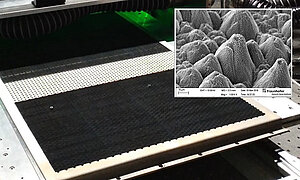August 12, 2021
The Fraunhofer Heinrich Hertz Institute (HHI) department "Fiber Optical Sensor Systems" is part of the new project InnoEly (Water Electrolysis Innovation Laboratory). InnoEly addresses the process of water electrolysis, the most commonly used process for the production of green hydrogen. The research team aims to improve the efficiency of this process so that hydrogen can become a widely usable energy carrier of the future. The collaborative project started in May 2021 and will run until April 2024. It received an initial funding of 1.2 million euros from the Lower Saxony Ministry of Science and Culture.
In order to use hydrogen as a green energy carrier, we need a process known as water electrolysis. Here, water is split into hydrogen and oxygen using an electric current. This process is very energy-intensive. With steadily increasing electricity consumption, hydrogen technology is therefore only environmentally friendly if its manufacturing process can be optimized.
This is where the InnoEly research team comes in. They aim to increase efficiency in the electrolysis process while reducing costs. To this end, the researchers are developing a novel catalyst unit. The goal is to increase the efficiency of conventional water electrolysis processes to over 75 percent.
InnoEly’s approach addresses the entire process of hydrogen production. The project partners are creating a toolbox of modeling and characterization components that can be employed for all three relevant water electrolysis technologies. These include alkaline electrolysis (AEL), acidic proton exchange membrane electrolysis (PEMEL), and high temperature electrolysis (HTEL).
Using AEL technology as an example, the "Fiber Optical Sensor Systems" department conducts targeted material functionalization. The team is working on electrodes already used in electrolysis as well as electrode components newly developed by the project partners. Using a femtosecond laser structuring process, the researchers functionalize different materials for electrocatalysts like nickel foams and support plates. The structuring optimizes the effect of the electrodes. With this, the so-called overvoltage, the amount of energy loss, can be reduced by up to 20 percent. This allows to increase the amount of hydrogen obtained with minimal optimization of the existing system. In a second step, the electrode components produced in this process are characterized. The obtained measurement data serve as a case study for testing and validating the modeling tool.
In addition to Fraunhofer HHI, the project involves Leibniz University Hannover, TU Braunschweig, TU Clausthal, the University of Oldenburg, DLR Institute for Networked Energy Systems and the Institute for Solar Energy Research in Hameln ISFH.
